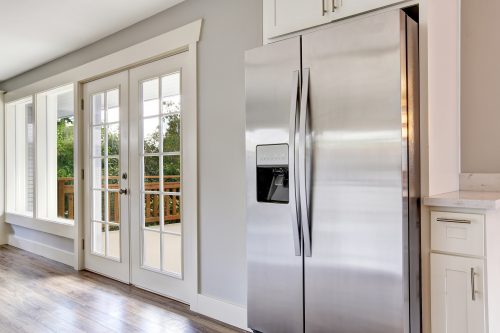You can’t live without a refrigerator, and you can’t turn it off. On top of that, the refrigerator is one of the biggest energy consumers in the typical home. That’s why it’s important to know when to replace your refrigerator and how to shop for a model that will cost you less in the long run. Let our energy-efficient refrigerator buying guide walk you through the most important steps.
Refrigerator Energy Efficiency
Generally speaking, older refrigerators are less efficient than newer refrigerators. There are a couple of reasons for this. First, the federal energy efficiency minimum standards for refrigerators have been tightened over the years, and will continue to get tighter in the future. And second, all refrigerators gradually lose some efficiency over time, even when they’re well cared for. The typical life expectancy of a refrigerator is about 14 to 17 years, and if yours is even older than that, you may be paying much more than you think to keep your food cold.
The federal ENERGY STAR program has created a calculator to help you estimate how much you could save by upgrading to a modern refrigerator. Simply enter your kilowatt-hour (kWh) rate from your most recent electric bill and select your refrigerator’s door style, approximate model year and capacity. For example, if your kWh rate is 12 cents, you have a freezer-on-top configuration, your refrigerator is from 1990-1992 and its capacity is between 19 and 21.4 cubic feet, the calculator estimates a five-year savings of $623 from upgrading to an ENERGY STAR-certified model.
Energy-Efficient and Inefficient Features
Modern refrigerators have many more bells and whistles than their old-timey counterparts, and which ones you choose can make a big difference in how much electricity your new refrigerator consumes. Some ubiquitous features, like automatic ice makers, only add a little bit to your energy bill. But others, like in-door dispensers for ice and water, and especially automatic freezer defrost, add more. So you should consider carefully which options really matter to you, because you’ll pay for them every month.
Among the newest generation of refrigerators, there’s one feature that can sometimes actually save energy: smart technology. Smart refrigerators have much more complex energy efficiency settings than ordinary refrigerators, and some models can do some pretty incredible things. For example, depending on where you live, you may be eligible for time-of-day electricity pricing in which the kWh rate is lower later at night, allowing you to save money by performing energy-using tasks during your free energy hours. Some smart fridges can save their big energy-consuming processes, like automatic freezer defrost cycles, for those times when electricity is at its cheapest.
A final set of options to consider is your refrigerator door configuration. Most refrigerators fall into one of four categories: freezer-on-top, freezer-on-bottom, side-by-side and French doors with a bottom freezer drawer. Of these types, the traditional freezer-on-top model is the most energy-efficient.
Refrigerator Size
If you have a big family, chances are you need a big refrigerator. Don’t think you can just get a smaller fridge and cram it full -- a lack of airflow inside your fridge is a recipe for poor energy efficiency or even food spoilage.
But for households of one or two people who shop for groceries often, a smaller fridge may do the trick. And generally speaking, smaller refrigerators consume less energy than bigger ones.
Speaking of size, you should also carefully measure the space where you want to place your refrigerator and compare it to the sizes of the models you’re considering. There should be at least once inch of clearance on all sides of the refrigerator, especially the back, to give the appliance room to breathe.
Energy Star Refrigerators
To make sure you’re getting the most efficient refrigerator that meets your needs, the federal government lends a couple of helping hands. The first is through its ENERGY STAR certification program, in which major appliances that meet high energy efficiency standards can earn the ENERGY STAR label.
You can look for this label anywhere refrigerators are sold, online or offline. But why not start your browsing from the comfort of your own home? Use the ENERGY STAR product finder to enter your criteria and find all the ENERGY STAR certified refrigerators that meet them. This shortlist can make refrigerator shopping faster and easier.
Check the Energy Label
The second federal program you’ll want to check out is the EnergyGuide program, which you might know from the yellow and black EnergyGuide labels that appear on certain appliances at retail. These labels give clear estimates of every refrigerator’s annual operating costs, based on the average national kWh rate of 12 cents. For a more accurate estimate, check your electric bill for your kWh rate before you shop so you can recalculate these estimates based on your own rate. Simply multiply the estimated annual kWh consumption on the EnergyGuide label by your own kWh rate to get your personalized estimate.
If your refrigerator is past its prime, start shopping today and consider how much you can save with a carefully-researched upgrade!

